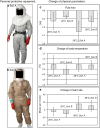Limiting factors for wearing personal protective equipment (PPE) in a health care environment evaluated in a randomised study
- PMID: 30668567
- PMCID: PMC6342303
- DOI: 10.1371/journal.pone.0210775
Limiting factors for wearing personal protective equipment (PPE) in a health care environment evaluated in a randomised study
Abstract
Pandemics and re-emerging diseases put pressure on the health care system to prepare for patient care and sample logistics requiring enhanced personnel protective equipment (PPE) for health care workers. We generated quantifiable data on ergonomics of PPE applicable in a health care setting by defining error rates and physically limiting factors due to PPE-induced restrictions. Nineteen study volunteers tested randomly allocated head- or full body-ventilated PPE suits equipped with powered-air-purifying-respirators and performed four different tasks (two laboratory tutorials, a timed test of selective attention and a test investigating reaction time, mobility, speed and physical exercise) during 6 working hours at 22°C on one day and 4 working hours at 28°C on another day. Error rates and physical parameters (fluid loss, body temperature, heart rate) were determined and ergonomic-related parameters were assessed hourly using assessment sheets. Depending on the PPE system the most restrictive factors, which however had no negative impact on performance (speed and error rate), were: reduced dexterity due to multiple glove layers, impaired visibility by flexible face shields and back pain related to the respirator of the fully ventilated suit. Heat stress and liquid loss were perceived as restrictive at a working temperature of 28°C but not 22°C.
Trial registration: ClinicalTrials.gov NCT03004690.
Conflict of interest statement
The authors have declared that no competing interests exist.
Figures






References
-
- Castle N, Owen R, Hann M, Clark S, Reeves D, Gurney I. Impact of chemical, biological, radiation, and nuclear personal protective equipment on the performance of low- and high-dexterity airway and vascular access skills. Resuscitation. 2009;80(11): 1290–5. 10.1016/j.resuscitation.2009.08.001 - DOI - PubMed
-
- Kümin D, Krebs C, Wick P. How to Choose a Suit for a BSL-4 Laboratory- The Approach Taken at SPIEZ LABORATORY. Applied Biosafety. 2011;16 (2): 94–102.
-
- Merens A, Cavallo JD, Thibault F, Salicis F, Munoz JF, Courcol R, et al. Assessment of the bio-preparedness and of the training of the French hospital laboratories in the event of biological threat. Euro Surveill 2012;17(45):20312 - PubMed
Publication types
MeSH terms
Associated data
LinkOut - more resources
Full Text Sources
Medical

